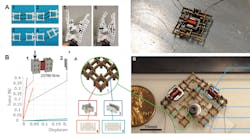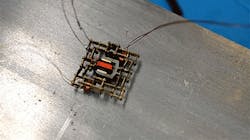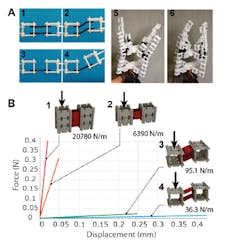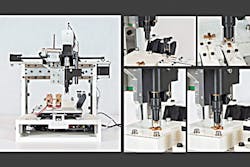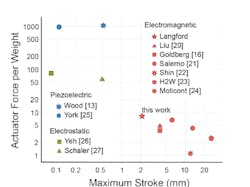An MIT team led by Professor Neil Gershenfeld has applied the “facts of life” to motors. Living things are built out of near-infinite combinations of just 20 amino acids, so would it be possible to create a kit of just 20 fundamental parts that could be used to assemble multiple mechanical constructs (perhaps a more-tangible comparison would be the use of well-known LEGO parts)?
The answer to Prof. Gershenfeld’s question is “maybe.” Their latest demonstration of the possible validity of the idea is a seen in a set of five tiny fundamental parts that can be assembled into a wide variety of functional devices, including a tiny “walking” motor that can move back and forth across a surface or turn the gears of a machine (Fig. 1).
They used a group of five millimeter-scale components, all of which can be attached to each other by a standard connector. The goal is to have a kit of parts that could be used to assemble different robots as needed, and even disassembled and reassembled into other configurations with strengths and sizes. For control, the team used parts with millimeter-sized integrated circuits, as well as parts with electrical connections in three dimensions.
These parts include rigid and flexible components (based on earlier published work), plus electromagnetic parts, a coil, and a magnet. They were assembled into a motor arrangement that moves in discrete mechanical steps, which in turn can be used rotate a geared wheel, see video here.
Their mobile motor—named Discretely Assembled Walking Motor (DAWM)—turns those steps into locomotion, so it can walk along a surface (Fig. 2) and video here.
Motion is energized via voice-coil actuator components that produce up to 42 mN of force with strokes of 2 mm. With stepping at rates of up to 35 Hz, the resultant velocity can be as high as 25 mm/s. Multiple DAWM systems can be linked to increase force, and they can be driven in-phase or out-of-phase to produce intermittent or continuous force, respectively.
The parts are 3.53 mm in their longest dimension and 254 μm thick; their smallest feature size is 200 μm. By embedding degrees of freedom in the parts themselves, the team was able to assemble mechanisms and linkages.
The flexural parts were fabricated using a multi-layer laminate technique that they called PC-MEMS (printed-circuit MEMS) or SCM (smart-composite microstructures); they’re made from layers of brass (100 μm thick) and Kapton (25 μm thick), joined with two layers of B-staged Pyralux adhesive (12.5 μm thick). The resultant parts have a hinge joint that’s much more compliant about its rotation axis than it’s off-axis—very desirable attributes for the basic hinged joint as well as a parallelogram linkage assembled from two degree-of-freedom struts (Fig. 3).
Handcrafting these mini-motors one at a time is feasible but not desirable. Instead, graduate student Will Langford developed a machine that’s somewhat of a hybrid between a 3D printer and a pick-and-place machine. It can produce complete robotic systems directly from digital designs (Fig. 4).
Here's a related video:
Prof. Gershenfeld says this machine is a first step toward to the project's ultimate goal of “making an assembler that can assemble itself out of the parts that it's assembling.”
The team rounded out their analysis of their device’s performance with a graph comparing the stroke versus acceleration/weight of their design to other research and commercial millimeter-scale actuators, with reference citations (Fig. 5).
The mini-motor project details were presented at the International Conference on Manipulation, Automation and Robotics at Small Scales (MARSS) in Helsinki, Finland, where their paper “A Discretely Assembled Walking Motor” (by Gershenfeld and Langford) was selected as the conference's best student paper (note: the paper only mentions Langford’s assembly machine in brief).
